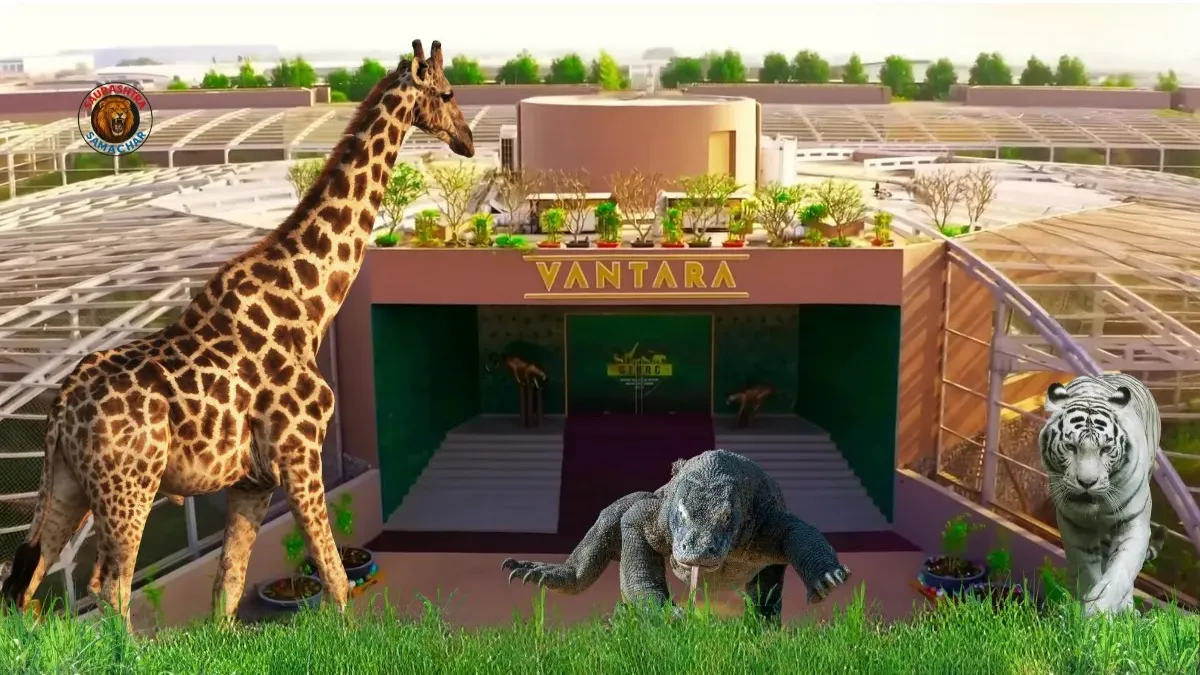Vantara news has been making global headlines after India’s Supreme Court ordered a high-level inquiry into the massive animal rescue and rehabilitation facility run by Anant Ambani, son of Asia’s richest man, Mukesh Ambani. The court’s directive follows a series of allegations ranging from unlawful wildlife imports to financial irregularities, sparking heated debate in conservation circles about the future of the animals housed there.
Supreme Court Steps In
On Monday, the Supreme Court of India announced the formation of an independent panel headed by retired judges to conduct a fact-based inquiry into the operations of Vantara, located in Gujarat’s Jamnagar district. The panel has been tasked with investigating:
- Alleged illegal acquisition of wild animals, especially elephants
- Compliance with India’s wildlife protection laws
- Concerns over financial misconduct and money laundering
- Suitability of Gujarat’s climate for thousands of exotic animals
- Complaints regarding whether Vantara is serving conservation goals or acting as a “private vanity collection”
The panel has been asked to submit its detailed report to the court by 12 September.
The order came after wildlife groups and activists filed petitions supported by investigative media reports suggesting massive and questionable animal transfers into the facility.
A Zoo Unlike Any Other
Vantara, which means “Star of the Forest” in Sanskrit, has been described as the world’s largest wild animal rescue center. Spread across more than 3,000+ acres of land adjacent to Reliance’s giant Jamnagar oil refinery, the facility houses an astonishing collection of animals. Reports suggest the following numbers:
- 200 lions
- 250 leopards
- 900 crocodiles
- Over 150,000 animals in total, including reptiles, birds, and herbivores
While Vantara is not open to the public, it markets itself as a rescue, rehabilitation, and lifelong care center for animals that cannot be returned to the wild.
Prime Minister Narendra Modi himself visited the facility and praised it as “truly commendable.” Yet, despite this recognition, conservationists remain divided on whether the initiative genuinely serves animal welfare or primarily showcases the power and wealth of India’s richest family.
Allegations and Investigations
A major investigation published in Süddeutsche Zeitung (Germany) and Armando Info (Venezuela) earlier this year revealed alarming details about the origins of animals at Vantara. According to their research, import data showed:
- 11,000 animals shipped from the United Arab Emirates (UAE), including orangutans and a mountain gorilla (a species that typically lives only in family groups)
- 100 giant otters and 142 giant anteaters from Venezuela
- 481 green tree pythons from Malaysia
- 520 hawk doves from Indonesia
The reports raised concerns about whether these imports complied with international wildlife trade regulations such as CITES (Convention on International Trade in Endangered Species of Wild Fauna and Flora).
Critics argue that instead of being a sanctuary for rescued animals, Vantara may have functioned as a massive private collection created through global animal acquisitions.
Vantara’s Response
In response to the Supreme Court’s order, Vantara issued an official statement promising full cooperation with the investigation team.
“Our mission and focus continue to be the rescue, rehabilitation, and care of animals. Vantara remains committed to transparency, compassion, and compliance with the law,” the statement read.
The facility insists that most of the animals were either rescued, abandoned, or could not survive in the wild due to injuries, habitat loss, or illegal trafficking networks.
Vantara also highlights its advanced animal care infrastructure, which includes:
- Elephant jacuzzis and hydrotherapy pools
- The world’s largest leopard rescue center
- Modern veterinary hospitals and specialized dietary programs
- Enrichment activities designed to mimic natural habitats
A Venue of Extravagance
Vantara was thrust into the global spotlight during the lavish wedding celebrations of Anant Ambani in 2024. The facility was one of the venues where celebrities and dignitaries from around the world attended. Guests were encouraged to wear “jungle fever” outfits to match the setting.
The multi-day celebrations included private performances by global pop icons Rihanna, Justin Bieber, and Katy Perry. The sheer scale of the wedding set a new standard in luxury and extravagance, with Vantara acting as both a backdrop and a symbol of the Ambani family’s grandeur.
This use of the animal facility as a wedding venue added fuel to activists’ arguments that the project was less about conservation and more about status display.
International Attention
The debate around Vantara is not limited to India. International wildlife influencers, including Forrest Galante, a US-based conservationist with a large YouTube following, have showcased the facility in glowing terms. His videos highlighted Vantara’s modern animal care methods and facilities, painting it as a global leader in animal welfare.
However, the international media’s investigative reports have painted a more controversial picture, suggesting that global animal transfers on such a massive scale are rarely possible without bending or breaking regulations.
Conservation vs. Controversy
At the heart of the Vantara debate lies a fundamental question:
- Is Vantara truly a pioneering conservation project that provides a safe haven for animals that cannot return to the wild?
- Or is it a private menagerie, fueled by immense wealth, that risks normalizing the commodification of wildlife?
Wildlife activists argue that real conservation should prioritize habitat protection and animal release programs, rather than creating vast enclosures where animals live permanently in captivity.
Vantara’s supporters counter that in a world where habitats are disappearing and illegal trafficking is rampant, such mega-facilities can save thousands of animals from death or abuse.
The Ambani Factor
The Ambani family’s involvement further complicates the issue. Mukesh Ambani, with an estimated net worth of $100 billion, ranks among the world’s top 20 wealthiest individuals. His empire spans petrochemicals, telecommunications, retail, and even luxury toy stores like Hamleys.
Anant Ambani, the youngest son, has long shown a deep personal interest in wildlife. Vantara is seen as his brainchild, fueled by his passion as well as his family’s virtually unlimited resources.
This financial power means that Vantara dwarfs most other private conservation efforts worldwide. For example:
- The Wilds in Ohio, USA, covers more than 10,000 acres (much larger than Vantara in land area), but houses far fewer animals.
- Vantara, despite being only 3,000 acres, claims to host more than 150,000 animals, a scale unmatched elsewhere.
What Happens Next?
The Supreme Court’s investigation will be crucial in determining the legitimacy of Vantara’s operations. Key outcomes could include:
- Validation – If the court finds that Vantara complies with all regulations, it may be celebrated as a global model for private conservation.
- Reform Orders – The court could recommend stricter oversight, transparency requirements, or changes in animal management practices.
- Sanctions – If violations are confirmed, penalties ranging from fines to restrictions on animal acquisitions could follow.
Whatever the outcome, the inquiry will likely set a precedent for private wildlife projects in India and potentially influence global conservation practices.
Key Facts About Vantara
| Aspect | Details |
|---|---|
| Location | Jamnagar, Gujarat, India |
| Size | 3,000 acres |
| Founder | Anant Ambani (son of Mukesh Ambani) |
| Claimed Animal Population | 150,000+ |
| Notable Species | Lions, leopards, crocodiles, elephants, orangutans, mountain gorilla |
| Unique Facilities | Leopard rescue center, elephant jacuzzi, advanced veterinary hospitals |
| Controversy | Alleged illegal imports, financial irregularities, “vanity project” concerns |
| Current Status | Under Supreme Court investigation (report due September 12) |
Global Reactions
The story has resonated worldwide, raising larger questions about the ethics of private conservation. Some international conservationists argue that super-rich individuals investing in wildlife protection could be a positive force if done responsibly. Others worry that such efforts risk creating exclusive wildlife kingdoms, inaccessible to the public and outside the norms of scientific conservation.
For India, the controversy has brought conservation into mainstream news, highlighting the tensions between economic power, celebrity culture, and animal welfare.
Also read: Vantara Wildlife Sanctuary: A New Haven for Nature and Conservation
Conclusion: Vantara News
The unfolding Vantara news saga is more than just a courtroom battle; it represents a clash of visions for how wildlife should be protected in the 21st century.
Should endangered species be housed in vast private facilities with state-of-the-art care but no hope of returning to the wild? Or should conservation focus on protecting natural habitats and ecosystems, even when resources are scarce?
As India’s Supreme Court awaits the inquiry report, the world will be watching closely. Whether Vantara emerges as a global model of animal care or a symbol of misplaced extravagance, its story has already ignited a crucial debate on the future of wildlife conservation.











